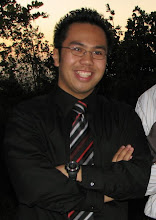
Above: The best of all pictures from Randy Pausch's Update Page featuring his daughter, Chloe.
DID YOU CATCH THE
HEAD FAKE?
I'm really looking forward to the year 2010. As I enter the new decade, it was welcomed by my mom and dad, my best friend Neal and his wife (who were in town visiting), and of course, James Taylor. Okay, I'll explain the latter.
It usually spend New Year's with my family (which has come to mean a lot to me), as I was never into all that celebrating/partying/yackety-smackety. I honestly think that the moment that the clock strikes 12 simply means that the calendar turns to another day. What's more important to me is seeing how the new year can mean something that +1 on the calendar but more what can I do with that year. So, I avoided anything on TV regarding countdowns (even the NYC ball drop) until the last 2 minutes of the Chicago countdown. After flipping through channels, I thought that James Taylor singing his hit songs on acoustic guitar on PBS would be perfect for a toned down night.
The video I found was described as his "Last Lecture," which was an academic tradition at Carnegie Mellon University that was to be given as if it was the person's final one... ever. For Pausch, it truly was. Although Pausch was championing his pancreatic cancer (he was outliving his original expectation to live 3-6 months), Pausch knew that at a point he was going to lose the battle (it had already spread to other organs). Yet, in front of a standing room crowd, Pausch proved that he was still much stronger than much of crowd by demonstrating his pushup skills (alternating between 1- and 2-handed versions). His "accidental celebrity" status (as he termed it) all started with a lecture that has attracted 10 million plus views on YouTube. In it, Pausch spoke about his dreams.
... and not just achieving them. How we make them come true. Who helped us along the way. How the dream came true even though it wasn't they way one imagined. The effort needed to achieve them. How grateful we need to be for what we can get...
In the talk he gives, called "Really Achieving Your Childhood Dreams," he tells the audience about how he wanted to play in the NFL, meet Captain Kirk, and even become a Disney imagineer (something I also have wondered about doing), and how the dreams had came true, but not in the way he had originally expected. Yet to Pausch, the outcomes were quite satisfying. I never expected to stay on board for his 1.25 hour long lecture, but his humor and personality caught my attention and grabbed my curiousity.
Just by watching the video, I knew that Pausch was a man that really wanted to live life to the fullest, and for knowing that he wouldn't be in the world much longer, I salute the man for having the strength to make the best of what remaining life he had. He used his efforts to improve awarness of Pancreatic Cancer and even coming back to Carnegie Mellon again to share more of his lessons
with the graduating class of 2008. Pausch passed away that year, 22 months after his original diagnosis of pancreatic cancer, leaving behind his wife and family. Although his life had ended, he went on to motivate his family and millions of others. He was featured on news outlets such as
Good Morning America, Time magazine, and
CBS Sunday Morning. He also wrote a book called
The Last Lecture which eventually went to become a
New York Times Bestseller.
After watching and learning about the Carnegie Mellon professor, I ended up making one of my objectives this year to work even harder towards my dreams... the dream of not just becoming a doctor, but to hopefully to turn out to be a great one.
Randy, thanks for making me learn a lot from my first lecture of 2010. Here's to you.
DO YOUR HOMEWORK: Watch the lecture. It might be just what you need to start the New Year. When you get a chance to watch his video, watch out for the "head fakes" (aka deeper messages) in his lecture and see if you can figure out what they are before he tells you what they are at the end of the video (I'll give you a hint, there's two). I know you'll get a few of those "Aha" moments when you learn what they are. Just trust me.




